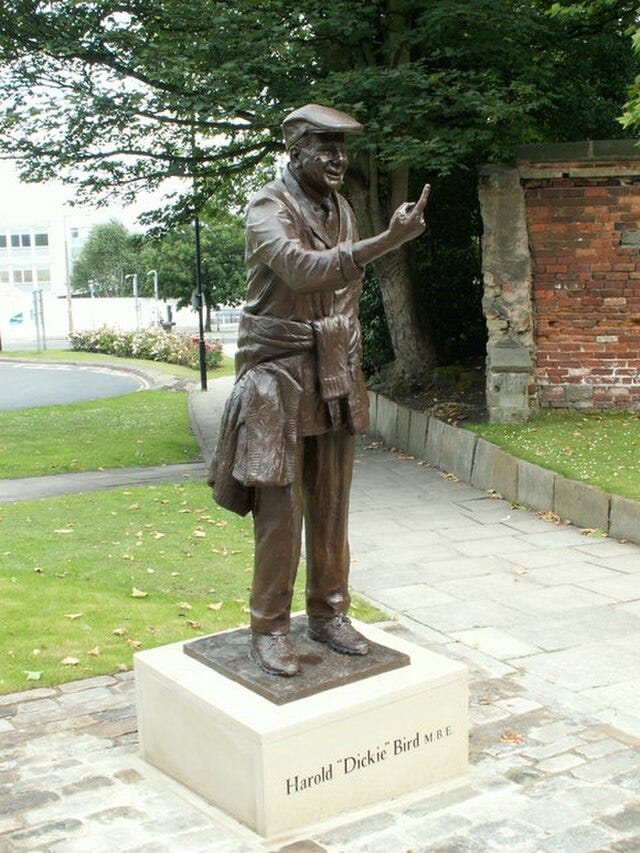The Incredible Shrinking Umpire
GH nods to some giants of the past
The death a week ago of Dickie Bird brought forth waves of nostalgia, not only for the man himself, but also for an age, when not only were men in white always right but somehow imparted a human touch to cricket’s pageant. Among many lovely tributes to Bird, Mike Atherton in The Times noted that ‘no umpire before or since has been quite as famous’, and Andrew Miller on Cricinfo that he can never really been replicated: ‘The conditions do not exist for another Dickie Bird to burst forth into the game.’
These conditions are not far to seek. The on-field umpire is now more or less a public-facing bureaucrat, part of a decision-making team clustered round machines of all descriptions arbitrating over ever more minute areas of ambiguity - hardly welcoming of Bird’s personality, which combined aspects of Captain Tom, Lord Denning, and Norman Wisdom. Part of Bird’s appeal, furthermore, was his playing to a home audience accustomed to his foibles: now, of course, an international umpire cannot be trusted to adjudicate in their country of origin. While My Autobiography became one of cricket’s all-time bestsellers, I wonder how many copies it sold beyond English shores.
Bird was actually the first independent umpire, standing in Zimbabwe’s inaugural Test, against India in Harare in October 1992. But he hated it: ‘There has been a lot of talk in recent years about neutral umpires and that has puzzled me,’ he wrote in My Autobiography. ‘As far as I am concerned every umpire in the world is neutral.’ His perspective had an acutely personal distinction: ‘I am a Yorkshireman. I played for Yorkshire. Yet I umpire their matches in the county championship…So why should it be any different at international level?’
The irony is that it was in the county championship that the first steps were taken to make neutrality official. In her excellent history The Men In White Coats (1987) Teresa McLean records.
Until 1883 counties took their own umpires to matches, and with them inevitably the traditional problems of allegiance and fairness. Another of the characteristics of umpires from mid-century on was their close friendship with the players, who were, as often as not, their old teammates. There were constant complaints about partiality, and in 1883 the nine counties agreed to change the system. Each of them sent to names of at least two umpires to the MCC secretary, who appointed two for each county match, making sure they were not from either of the counties playing.
The road to third-party umpiring at international level was far longer, pot holed by cultural assumptions and global rivalries. Nothing in days of yore taking a short time where it could take a long time, the first moves were made as early as the 1930s, when Bill Woodfull sought to lure England’s Frank Chester to Australia. But while Chester credited Woodfull with doing ‘his best to start a neutral umpire movement’, Chester himself shared Bird’s view that they were ‘not a necessity’.
I won’t here traverse the arguments for and against technology in arbitration - that is, perhaps, for another time. But Bird’s death was a reminder of a dimension of cricket culture that has, for better and worse, passed away with little remark - you have to be getting on, in fact, to remember the umpire as character, and also as controversialist. The scope was never substantial. For all that John Arlott said ‘umpiring can make or ruin a game’, its literature is small: I count a score of autobiographies in all the game’s vast libraries, and I can’t see anyone forking out for The Dharmasena Bums. But while we await a tell-all memoir by Snicko, I thought I’d rove over what there is to read on the subject.
Keep reading with a 7-day free trial
Subscribe to Cricket Et Al to keep reading this post and get 7 days of free access to the full post archives.



